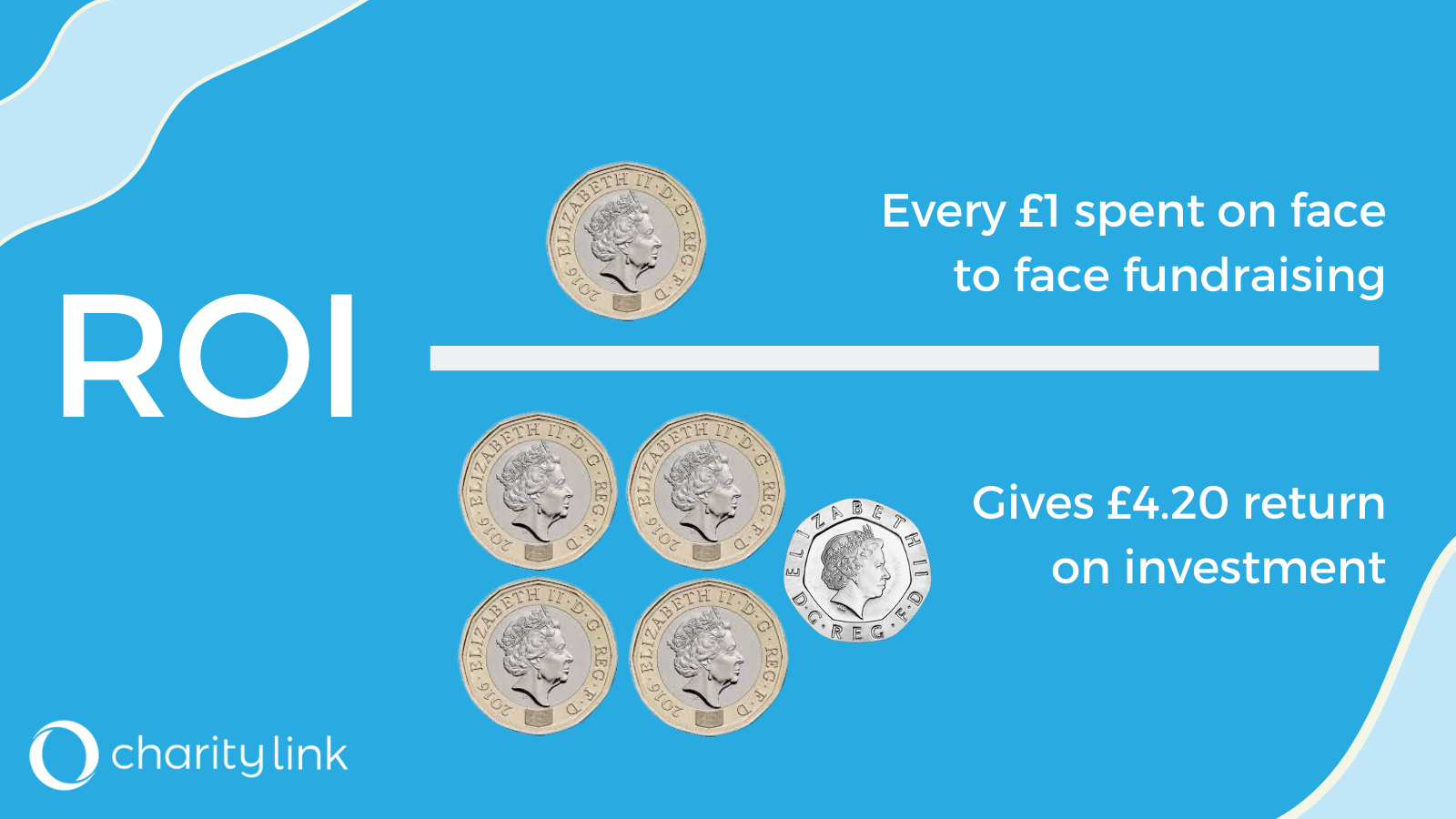Why charities should invest in face to face fundraising
Fundraising directors face a paradox: Members of the public say that they want to choose which charities they will support and don’t want to be asked – but then over 80% don’t donate to charity until they’re asked! Of all the different types of fundraising, there’s almost no other sector where face to face activity is the best fit, especially when done well. To see if that’s true, we explore some popular fundraising alternatives on raising money for charity, as well as looking at how the face to face fundraising strategy is advancing.
Charity Link face to face fundraising for Guide Dogs UK
What is face to face fundraising exactly?
Essentially, face to face (F2F) is where professional fundraisers approach and connect directly with members of the public to sign them up to regular monthly donations. These donations might simply be an agreed amount, or they might be in the form of a lottery entry. Although the nature of fundraising naturally leans towards charity, arguably you could raise funds for anything.
What are the alternatives to face to face fundraisers?
Prior to GDPR (General Data Protection Regulation), it was quite plausible for charities to send mass mailings by post or email. At the time, the technique worked fairly well for charities, with even a small response rate justifying the costs.
But it wasn’t to last.
GDPR was introduced to help regulate the exploitation of people from the huge numbers of private companies who bombarded the public and generally abused their data privacy rights. Although a good move, it unfortunately also severed any option for charities to approach members of the public without consent.
So how did charities respond?
To try to mitigate losses, charities began turning to DRTV (Direct Response Television). They’d advertise their causes on non-mainstream TV channels to keep things more affordable.
This method initially provided a relatively decent return on investment and success could be measured easily, provided there was a system to attribute a donation to the TV ad (for example, via a code).
But with so many charities turning to DRTV, the market became over-saturated. Predictably, TV ads became far less effective.
Many charities have now withdrawn from television advertising altogether, or have completely overhauled the way they participate, along with expectations of results.
Charity fundraising ideas
We all know humans can be seriously creative and there are many hundreds of ways to raise money for a cause.
Nobody could forget the craze of the Ice Bucket Challenge raising awareness and funds for ALS, or be oblivious to the world’s biggest Macmillan Cancer coffee mornings. More recently we were all moved by Sir Tom Moore’s record breaking fundraiser garden walks for the NHS during the first year of Covid19.
So we know it’s possible to tap into people’s hearts and pockets with a single great idea.
But these ideas tend to be one-offs and, despite the ingenuity and momentum, don’t create the consistent flow of reliable income that charities need to function into the long term future.
What about digital marketing for fundraising?
To donate online to charity takes mere minutes, which is clearly the most attractive feature of going digital.
Clever, data driven analysis means that personalised online advertising and promotion can be specifically targeted at your chosen audience.
Inarguably, to not be easily found online is surely to miss the biggest marketing trick. From Google ads to Facebook feeds, from witty tweets to Youtube ‘how to’ guides, retailers and private companies alike are everywhere online ready to grab the next big opportunity.
Any company worth their salt have allocated at least some effort to digital media and of course many of the giants have achieved incredible success. Charities have also been able to enjoy the benefits of the digital era especially in reaching wider audiences than ever.
But of course, along with great success typically comes big budgets too. However ingenious or heartfelt the charity campaign, if nobody sees it, it’s not meeting its objective.
As the popularity of social media platforms have soared, the rules have become more stringent. The once visible charity facebook pages have slid to the back of the queue. Where historically if you ‘followed’ a cause it would be shown in your newsfeed, these days you have to pay to get seen.
But unlike Amazon or ASOS, the truth is that nobody wakes up in the morning and suddenly decides they are going to donate to charity (or very rarely at least). Online fundraising sites are competing with the most agile and cash-rich companies for advertising space who have the advantage of selling something people might actually want.
To make it even harder, cutthroat marketing agencies know exactly how to make the kill, which makes the often low budget charity ads (launched inhouse), even less likely to be seen. Charity ads often end up in front of the ‘easy score’ audience, who’ve expressed interest in charity and most likely already donating elsewhere. The chance that they will voluntarily click through to a charity donation website and sign up to regular giving without prompting is pretty remote.
So how is face to face better?
By contrast, face to face fundraising provides something that no digital platform can: Human connection. A person-to-person interaction is simply not replaceable by a machine - and it never will be.
With F2F, charities get to be represented how they intend; complete with the real time passion, energy and storytelling. And let’s face it, storytelling is the foundation of every culture in human history.
When done well, a simple chat can lead to a donor that’s a long term and committed supporter. These two magic words are the true lifeblood of types of donation. Dare we say even better than a lump sum in one.
Committed ongoing donors provide charities with a predictable long term income stream of unrestricted funds.
They can plan into the future without the worry of constantly having to raise short term funds to deliver their objectives. In short, it gives better security and ultimately helps more for the cause.
And the figures back it up.
In 2017, government research showed that 40% of people donate via direct debit, raising an incredible £3.6 billion. It’s simply unfathomable to be able to raise that kind of money in one-off fundraisers, no matter how impressive or imaginative.
Without doubt, these regular types of income makes a massive impact on charities’ ability to plan and reach their goals.
What about ROI on face to face fundraising?
Looking at the return on investment from this form of fundraising is important to see its true worth.
Research by NCVO (National Council for Voluntary Organisations) suggests that, on average, £1 spent on F2F fundraising, delivers £4.20 in return. This is the kind of rate that any marketer would drawl over.
To add to the attraction, included in the package is free brand awareness, as well as the ability to drive huge volume; hundreds of thousands of donors sign up to direct debits as a result of F2F activity each year.
What are the disadvantages of face to face fundraising?
Like with everything, there are downsides.
For a start, charities do receive complaints off the back of face to face activity. This can be because of any number of things such as where a fundraiser hasn’t communicated correctly, or the member of the public has reacted in a particular way. Indeed, most complaints received relate to the method of fundraising rather than the individual fundraiser’s behaviour.
Here at Charity Link, we record complaints ratios at around 1 complaint per 1000 donors signed up; a figure which we’re pretty proud of and have worked hard to achieve.
It’s widely believed that complaints should be based on the number of conversations that we have with members of the public, (numbering into the millions across the entire industry), because when measured like this, shows the industry performs incredibly well.
Unfortunately we can’t be certain of the number of conversations had, only of the number of donors actually signed up.
But although the percentage of complaints is tiny, some charity trustees feel that the perception of face to face fundraising might jeopardise their reputation and steer clear.
What’s the fundraising industry doing to improve?
In response to complaints and the growing number of charities using F2F now, the whole fundraising industry is improving rapidly. Since 2016 key changes have contributed to raising the bar, helping to propel face to face fundraising into a much more positive light.
Fundraising regulator code of practice
Established in 2016, The Fundraising Regulator replaced the Fundraising Standards Board (FRSB).
This independent body set and maintain standards with the Code of Fundraising Practice, with the latest edition coming into effect in October 2019.
The code includes specific guidance on how to keep fundraising legal, honest, open and respectful and it applies to any charity that spends £100k or more on charitable fundraising and to third party fundraisers in the UK.
The Fundraising Regulator also investigates unresolved fundraising complaints, checking for any breach of the code and manages the Fundraising Preference Service (FPS), allowing members of the public to request that a charity stop contacting them.
Sir Stuart Etherington
The Etherington Report was written by sector leader, ex CEO of NCVO and long term commentator, Sir Stuart Etherington and became the defining ambition of what the industry could become.
In his publication ’Voluntary Action: A way forward’, Sir Stuart makes recommendations to encourage both the growth of community action and establish better financial frameworks.
“The issue is not, as it has been in the past, a binary one: more or less state funding versus more or less personal funding. It is a move towards something new: a shared role, with the state and citizens sharing the burdens of civilised provisions for those of us who need it. The whole may thus become much greater than the parts.”
Eighteen suggestions overall are broken down into three key categories, which we cover briefly:
Establishing a more reliable financial structure
Allocating dormant assets, reforming practice on obtaining funding and overhauling the social investment industry (potentially changing the Big Society Capital (BSC) are all centrepieces in this category. The independence of the Big Lottery Fund (BLF), agreements between national and local organisations and exploration of direct local level charity are other recommendations.
Institutional framework
Reviews of legal and tax framework, the public sector commissioning practice and the investment and empowerment of community leadership all feature.
Wellbeing indicators should be established between the ONS (Office for National Statistics), while the civil society sector and digital transformation should be a focal point for the private sector, government and charitable foundations.
Public participation
Understanding further how volunteers are recruited, retained and treated. Schemes that implement values about volunteer work from schools right up to the work to retirement transition. How social activity could be interwoven into basic universal income, and examining how the NSC (National Citizen Service) fits into existing civil-society activity.
The Merger of the PFRA into the Institute of Fundraising
The PFRA (Public Fundraising Regulatory Association) merged into the IOF (Institute of Fundraising) in July 2017. It then became a chartered body after its royal charter was officially sealed and approved and so is now known as the Chartered Institute of Fundraising.
The result is a coherent rulebook on all methods of face to face fundraising and for private site fundraising, as well as an extensive mystery shopper programme.
Since then, the IOF has published data to show that penalty points from mystery shops for both street fundraising and private site fundraising has dramatically declined.
In the first year of its existence 2016-17, 44% of mystery shops in private site fundraising incurred a penalty i.e. breached the rulebook
In 2017/18, (despite a huge increase in the number of mystery shoppers), the number of those incurring penalty points fell to 28%
Likewise for the same years, penalty points for street fundraising fell from 19% to 16%
The number of actual penalty points incurred has also fallen considerably – from an average of 82 points per mystery shop (in the first year of the mystery shopper programme) to 28 in 2018. The clearly shows real signs of progress in both the understanding of regulations and the delivery of compliant fundraising.
“In our experience, although the environment has got tougher, we’ve found it’s possible to sign up long term donors with low attrition rates and low complaint ratios in a wholly compliant fashion.”
- Graham Sumeray, CEO Charity Link
Giving Trends
And it’s not just the penalty point data that show advances in the charity sector.
Rapidata work to provide the charity sector with information on giving trends via direct debits.
Their ‘Charity Direct Debit Tracking Report’ 2019, revealed a reduction in cancellations of direct debits to charities in 2018, but also a reduction in new supporters. In fact, there was nearly a third less new regular givers than in 2017.
This was a probably a casualty of the aforementioned GDPR data protection laws (introduced mid-2018), where many charities couldn’t tap into new donor opportunities as before.
Despite this initial drop, 2019 came back fighting and saw a strong rise in the acquisition of regular giving donors. It was this year that the charity sector saw a whopping 55% increase in regular giving signups.
As well as data on cancellation and acquisition rates, we can gain more insight from ‘no show’ payments. This reflects the rate of those who sign up, but never make their first gift donation.
These figures parallel the ‘Charity Cancellation Average Benchmark (CAB), where charities are given an industry standard for monthly direct debit cancellation rates. In 2019 this rate remained steady at 3%.
The Institute of Fundraising
The IoF has also initiated a self-certification programme, which further cements the expectation on proper conduct when raising funds.
The programme requires agencies and charities with in-house fundraising teams to submit information on their policies and procedures. As part of the process, the IoF also attends their training sessions.
Public Perception
So all of this is a great step in the right direction and many members of the public (along with many fundraising directors according to a recent survey) would be surprised to discover how much F2F activity is actually regulated.
Members of the public don’t differentiate between types of fundraising such as those that are fully compliant and those that aren’t. Like many other industries, there are plenty of the latter who can and do give us all a bad name.
What may also surprise many, is how much better the industry is performing in regards to those who adhere to vigorous compliance and training programmes.
Of course, more can always be done in this respect.
The IoF certification programme needs to be audited, we’d like to see it as mandatory (i.e. charities should be obliged to only use third parties that have been certified and audited) and it needs to be all-inclusive, including in particular, lottery fundraising).
So what are the challenges for the industry?
The first and foremost is finding, training and retaining the best fundraisers we possibly can.
This is no easy task, especially when so many think that it’s only a job for volunteers or retirees. Paid fundraising is as much a profession as any other and the IoF’s move towards chartered status is to be applauded, especially if it changes perception of the role.
Charity Link have a bespoke in-house recruitment service that has gone through many vigorous tests to ensure it’s the best end user experience possible.
From the initial talent scout to the vetting, interview process and training, we believe we have found the formula that filters out the very best potential.
Of course, the reality is that despite initial promise, the role of fundraiser isn’t for everyone, but we believe everyone has potential!
Upon succeeding the interview process, candidates are then provided a place on our intensive week long training academy. Ongoing mentoring and support from there gives the fledgling fundraiser the best possible chance of success. We then hope to motivate with ongoing targets, incentives and rewards.
But the honest truth is that to be a successful fundraiser is incredibly difficult.
It’s truly humbling to think of all the fantastic fundraisers out there, showing such resilience. To engage members of the public positively, even after their approach may have been rejected many times during the day, often in very challenging weather, takes real character.
Where to fundraise?
The second biggest challenge, for private site fundraising, is finding great venues.
Only about 20% of venues that might be available to other companies seeking direct debit sign-ups (sky, virgin, utility companies) are available to the charity fundraising industry.
This is often due to all sorts of misconceptions.
Again, there are too many operators who either do not abide by the IoF’s rules for “booking” venues or openly ignore them. There are even stories of lottery fundraisers chasing members of the public around the aisles to get them to sign up!
All this does is close off our route to market – why would venue managers allow charity fundraisers to attend their venues if they are going to behave like that?
We must (and do) nurture these venues, taking good care to look after them as the lifeline they are to us.
The future of charity fundraising
If charities want a vibrant, successful alternative channel to other methods of fundraising, which can deliver a large volume of committed long term donors, they must support the sector.
Support means
Committing themselves to their agencies to allow them to do their job well
Sharing information with their agencies
Working with their agencies to adapt to emerging challenges
Giving them dedicated areas to work in so that they know they can work without clashes, which help nobody
Developing those areas making improvements where possible to optimise every opportunity
Checking on compliance (both of fundraisers and venue booking)
Most of all, it means working, truly, in partnership. The rewards are huge and there has never been a better time to invest in F2F!
If you’re from a charity that’s looking for support in fundraising, we say take the plunge!
We welcome new conversations and invite you to reach out for a chat about how we can potentially help your charity reach its goals.















